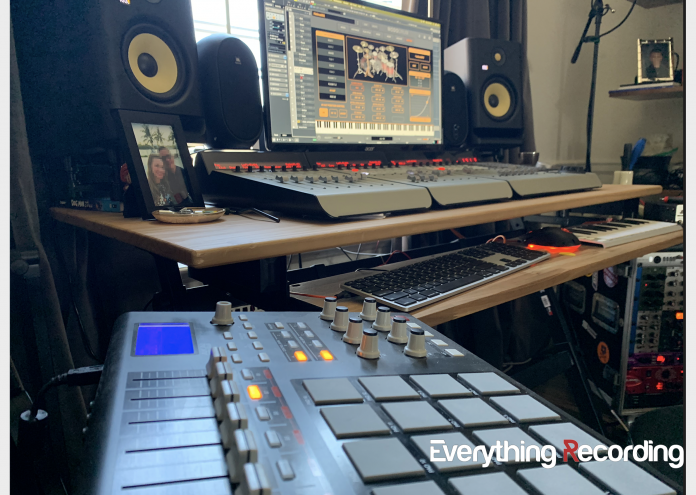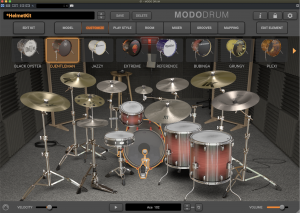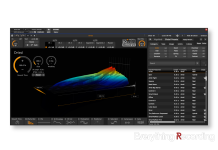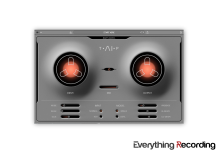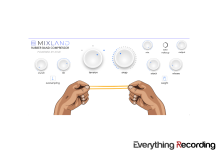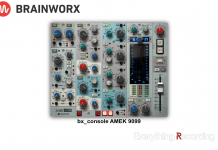(MODO DRUM – loaded up and ready to rip)
- Versatile selection of drums and acoustic environments
- First-of-its-kind ability to edit virtually every acoustic parameter
- Breathtakingly accurate
- Intuitive and user-friendly interface
- Cymbal editing and selection not quite up to par with the drums themselves
- Mixer, multiple mics and routing are unrefined
- No brushes or mallets at this time
THE BIG BANG
Released in 2003, FXPansion’s BFD virtual drum software was truly a monumental innovation – a sample-based, customizable and expandable software instrument that put the sound of true drums at the fingertips of producers and “virtual drummers” around the world. Before BFD, those looking for the sound of true live drums in their productions had two choices: Spend several days and thousands of dollars miking, tuning, playing, editing and mixing a live drummer -OR- deal with the blatantly-obvious-sounding and labor-intensive sample libraries (or even worse, sounds from PCM ROM libraries).
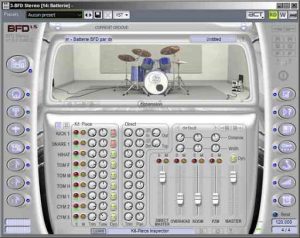
Now you could not only “build” the studio kit you wanted from a library of kicks, snares, toms, and cymbals, but route their individual tracks into DAW channels and mix them like real drums. Those unable or unwilling to program parts could tap into a vast collection of pre-played bars. But those who could, could put the extra time necessary to program in the nuances that made the results far more than just “passable”. The results were sometimes better than what you could get from a rushed or compromised studio recording, to be honest.
In the many years since BFD’s introduction, a litany of similar products has come to the fore. EZDrummer, Superior Drummer, Virtual Drummer, Steven Slate Drums and a dozen others continue to play “hand over bat” with more features, drums, microphone and room emulations, deeper layers of multi-samples, “famous” studio album recreations and literal terabytes of expansion packs. But at the very core, the technology has remained the same: Record a drum three hundred times, layer each piece by velocity with “alternates”, and load it up.
DOMO ARIGATO, MODO
IK Multimedia have begun a tectonic shift in the way the sounds, and idiosyncratic responses of acoustic drums are recreated with the introduction of MODO DRUM. Whereas their competition labors to cram as many possible sonic variations of one piece of wood or metal under each key, MODO is the first to implement physical acoustic modeling – giving you simply unprecedented control of every drum’s resonance, material, head type, tension… even bearing edge shape.
Physical modeling technology was first introduced in the 1990’s original “rave craze” when all those discarded old Roland Jupiters and Moog Prodigies suddenly quintupled in value and musicians fetishized the classic squeal and squelch of classic oscillators and filters. But the digital world wasn’t taking this trend lying down and introduced “virtual analog” DSP technology like the original Clavia Nord Lead and Propellerhead’s Rebirth. These recreated analog’s quirky nuances – not by sampling waveforms, but by digitally emulating the way those ancient transistors made them. As someone who had a few actual analog synths at the time, I was hooked on the Nord by the third preset.
Twenty years later, computing power has exponentially increased more than ten-fold, making the possibility of real-time manipulation of something as complex as acoustic drums an actual, if not daunting possibility. The difference in creating a physical model of a couple of sawtooth waveforms versus an actual drum (much less several at once) takes an insane amount of programming and CPU cycles, making even the very idea very aspirational – even with the multi-core, hyperthreading goliaths packed into today’s machines.
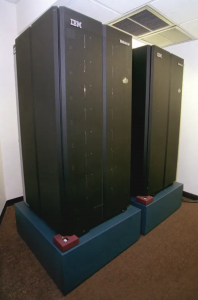
Of course, IK Multimedia are no strangers to modeling – their AmpliTube virtual amp and cabinet software releases are well-established mainstays in the category. But now they’re not simulating tubes and transistors, but the instruments themselves. MODO DRUM is actually the second salvo from IK in the modeled instrument world. MODO BASS, released two years previous, is a very impressive recreation of extremely lifelike electric bass tones, sounds and the natural variations that come from human hands (imagine if Thor‘s “engineer” had MODO BASS – this may have never happened). Again – these are not samples, but an actual DSP model that recreates the genesis of the sound, not sound itself.
Think of just hitting a snare drum set up in front of you and listening to the differences as you hit it. The differences between the strike of the left-versus-right hand. The difference in overtones as the stick strikes closer to the center or the rim, the tension of the head, the sympathetic vibration of the bottom head and the snares strapped across. Now multiply that by variations in shell and head material, the weight and material of the sticks, the tension of the snares and you’re beginning to see just what a monumental task this is to recreate digitally. But conversely, think of just how many individual samples this would take to be true to life (to say nothing of creating software that could manage thousands of samples, per hit, that quickly).
USED IN THIS REVIEW:
- 2018 Mac Mini
- 6-Core Intel i7 @ 3.2gHz
- 32 GB RAM
- External 2TB RAID 1 Array (2 x 2TB WD SSD Drives)
- Cubase Pro 10.5
- Mac OS Mojave
FROM INSTALLATION TO PERSPIRATION
If you’re currently a user of any recent virtual drum instruments, you might think the 7.1GB download seems a little… light. Drum sample libraries have been known to eat up tens, if not hundreds of available gigabytes (and hopefully you remembered to save to an external SSD this time!)
But wait… if this is just software, doesn’t several gigs of data seem a little… much? Well, that’s where MODO’s first “half measure” is exposed. MODO may use physical modeling, but it’s still using multi-samples as the raw material in some places (ahem: the cymbals). The “nuances”, the head tension and snare rattle and so on are where the modeling kicks in. The shells lean much more on the modeling algorithms while the cymbals are still much more sample-based – at least for now.
Anyways, getting MODO up and running is a fairly up-and-down affair and, once authorized, you’re ready to boot your DAW of choice and get to the fun stuff.
CAREFUL, M-O-D-O ALSO SPELLS “DOOM”
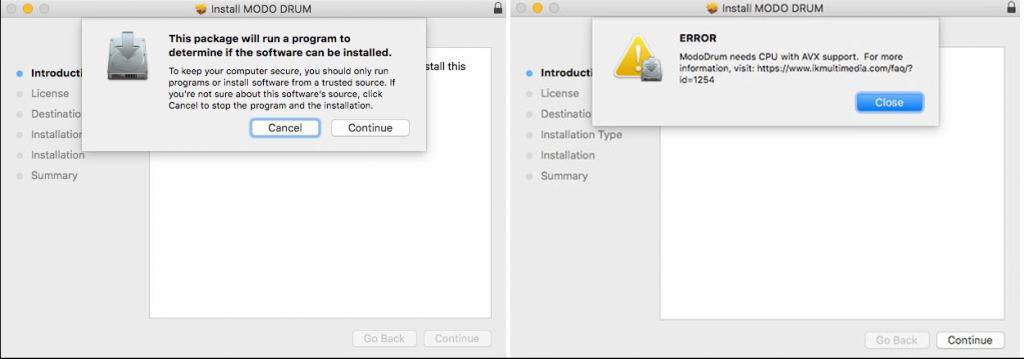
A note of caution here: MODO requires later iterations of Intel architecture, found on Sandy Duncan or London Bridge or whatever the later models are called these days. Your old pre-air-freshener Mac Pro, though still a handsome and capable piece of computing technology, lacks this pesky little thing called AVX (short for Advanced Vector Extensions). Without AVX, you’re SOL. Luckily this is an easy thing to check on your computer before purchasing. Word around the campfire is that more and more pro audio instruments and processors are going to be taking advantage of this in the future.
The stated minimums from IK Multimedia are an Intel Core i5 or higher (or AMD Quad-Core for Windows) and 8GB RAM. Just like every other plug-in out there, you may not be able to run this plug-in wide open at 32 sample buffers with lower cores or thread counts.
FIRST IMPRESSIONS
Your first blush at MODO is going to be a very simplified take on what this software is actually capable of. An elegant interface pops up with a visual carousel of MODO’s ten pre-built kits (that also include an acoustic space and a certain amount of eq and processing in the software’s virtual mixer). Everything’s mapped by default to the GM standard, so getting right to making some noises is a very short skip and jump.

These preset kits range from modern studio affairs (the bass drum logos are not exactly subtle about what brand of drums are in use) to Ringo’s black oyster Ludwigs, to be-bop to genre-specific nods like “DJENTLEMAN” and “GRUNGY”. The graphic on-screen representations are accompanied by some of the most over-written copy outside of a Sweetwater catalog. For example, instead of simply saying “Modern Kit”, you’re treated to a love poem that states it’s “…marked as a philosophical shift in drum-set construction, this classic, timeless kit represents a major advance in design…” It’s got everything but the “Add To Cart!” button beneath. I guess nobody told IK Multimedia’s UX team that drummers aren’t big readers*.
(* As a drummer of 36 years, I am allowed to make drummer jokes. You aren’t.)
Anyways, if you’re one of those ‘Preset Petes’ and just want to pepper up some General MIDI spec files, this is probably where your ride ends. One preset, one DAW fader, hello, goodbye, bing, bang, boom. And if you ARE one of those people, this is an incredible piece of software for doing just that. It certainly will wipe the floor with the “Rock Kit 2” preset on your mothership keyboard. Of course, if you are one of those people, I’m not sure what you’re doing on this site. Read on anyway, we’re getting to the fun stuff.
THE CUSTOMIZE BUTTON BECKONS
Once you’ve found a kit that is in the general direction of the pieces, sound, and vibe that you’re after – it’s time to get under the hood and really see what gives MODO its mojo.
You’ll feel BFD deja vu in the main “customize the kit” area, where you can swap pieces from all ten kits into the Frankenstein of your design, as well as assigning one of several acoustic environments from controlled to cavernous. A quick caveat though, these preset kits do not allow additional pieces, so if you’re going to be using lots of cymbals or toms, go for the “Wet Dream Theater” Reference Kit and start disabling all the unneeded parts – ironically you can only dis-able pieces. A “start from scratch” option would be, to say the least, a welcome addition.
But the real “holy-crap-on-a-pita-it-does-that?” happens when you start editing of the individual pieces. Whereas MODO’s contemporaries offer little more than tuning and a simulated amount of mic bleed, MODO gives you an absolutely insane amount of control. Take for example the snare drum. You are presented with options for head type (clear, coated, hopefully, vents and number of plies soon) for both the top and bottom head. The depth and diameter of the drum. The size and tightness of the snare wires. The damping of both heads. And, in a pure stroke of genius, the primary contact area on the head for both sticks.
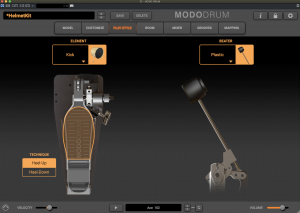 The bass drum allows you the options of not only head type and tension, depth, and diameter – but options for leaving the front resonant head on, off or ported and the material of the beater itself. Toms are a similar affair again with the added benefit of editing all of them as a group (if you want), and giving you a knob for virtually every possible facet of what creates the resulting sound.
The bass drum allows you the options of not only head type and tension, depth, and diameter – but options for leaving the front resonant head on, off or ported and the material of the beater itself. Toms are a similar affair again with the added benefit of editing all of them as a group (if you want), and giving you a knob for virtually every possible facet of what creates the resulting sound.
Given all these available edit points and parameters, you could easily be lulled into hearing things that aren’t really changing that much – for the better, worse or otherwise. But here’s the thing: The realism on the drum shells is subtle, tangible and flat out amazing. I say this not as someone agape at the slick UI, but as a drummer and an engineer. I have both played and recorded hundreds of my own and others’ kits while meticulously tending to these countless details. After all, these details are the difference between good and great drum recordings.
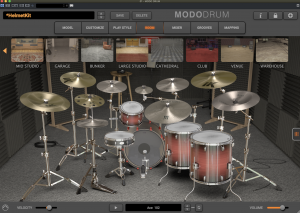
As stated before, the cymbal selection – though not as handsome as the drums themselves – is still enough to keep you from booting a second instrument with a better selection. The “brands” are subgrouped into three major slots and telltale logos to match. You’ll at least be able to control damping, hi-hat distance, etc. “Sound-wise” there’s a group of K Zildjian, earth-toned Bosphorus and “vintage-y” sounding lids, as well as some outliers like an “o-zone” crash and a painfully-accurate $39 Wuhan china that makes one remember that the Coronavirus is only the second-worst thing to come out of that part of the world.
MODO’S MIDI MODE
One of my favorite parts of MODO’s very well-thought-out interface is the keymap editing. With so many pad and kit controllers out there, building custom keymaps easily is a crucial layer that sometimes feels like a cumbersome afterthought from MODO’s contemporaries. Loading the keymap editor instantly shows you just how deep the capabilities of MODO truly run, with the ability to assign a key or continuous controller to a dizzying array of articulations.
Without so much as glancing at the manual, I was able to quickly create several different setups for my handy AKAI MPD32. The first was a quick “main drums and cymbals” affair across all sixteen pads, the second had a half dozen snare articulations separated to the left and right and the third let me “play” the cymbals with pads assigned to, for example, bow hit, stick hit, swim hit and bell hit for each crash. The “MIDI learn” function is contextual and there’s a low risk of “upsetting the apple cart” by accidentally reassigning a key or pad.
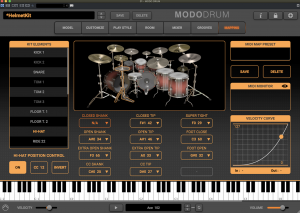
Being able to quickly build, edit, save and load different keymap setups far better than my experience with MODO’s competition was a very solid feather in their cap. Normally this is the part of setting up drum instrument software that is tedious and dreadful – but I’m confident that any controller brought into the studio could be up and running in no time.
One thing our jazzier hep cat friends will be quick to notice is there are no brushed or mallet options for any of the ten kits. I’ll just go ahead and say it: Jazz drummers are unapologetic purists and would sooner swallow their tongue than use a virtual drum kit (I noticed MODO BASS doesn’t have standup or acoustic bass either…) But composers who need tonal versatility might balk at the lack of these options. Not sure if that’s in the cards for subsequent versions, but if that’s on your list of “must-haves”, this is an unfortunate non-starter.
MY MIXER OR YOURS?
The mixer section will likely feel familiar to anyone using “[ADJECTIVE HERE] DRUMS” as their current drum instrument. Individual instrument channel faders from big to small are lined up left-to-right where you can assign some EQ and compression, as well as routing bussed tracks like overheads and room mics. Thanks to nice-to-haves like classic compressor emulation and extensive EQ-ing options, you could easily do all of the mixing inside-the-box-inside-the-box, leaving the output on your DAW mixer as a stereo output pair.
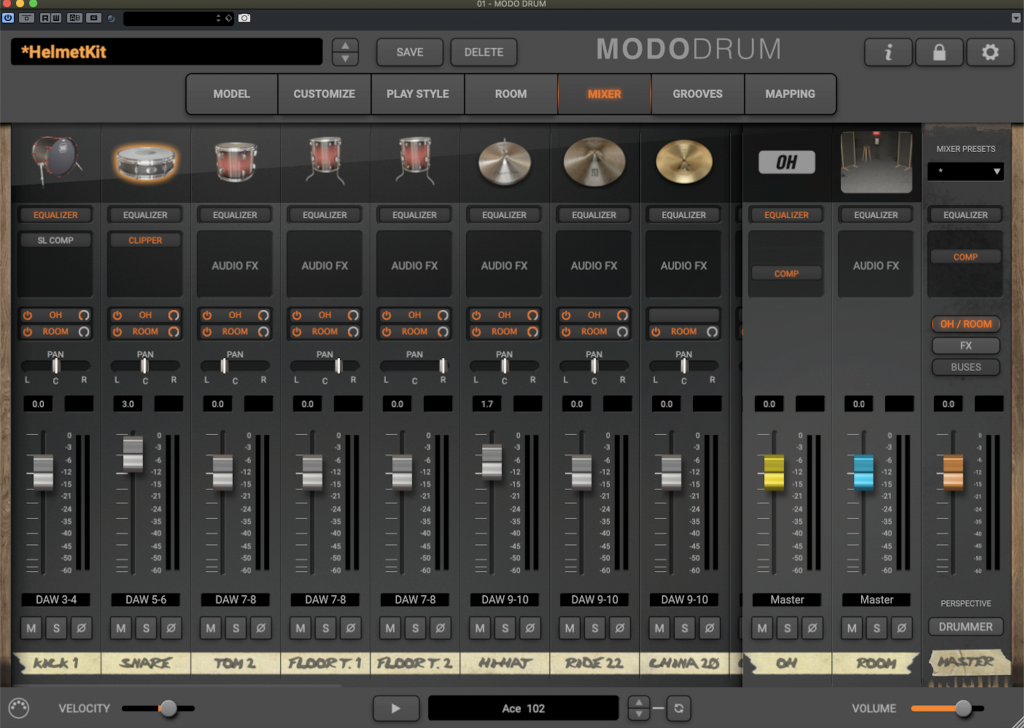
I’ve never been one to do this personally. I want all of the individual outputs up on faders just as if I were mixing actual drums. This is where IK steps in it unfortunately. First of all, there are no mono outs. Something like a kick or snare is a mono track by its very, single-source-point nature. You would never sit down at a console and see “Rack Tom L” and “Rack Tom R” because we don’t mic toms in stereo. So only being able to bring these up on stereo tracks hits your studio resources one way or another. You have to process twice as much material. Every channel eats up twice the amount of horsepower. Never mind those of us who use analog outboard to process these individual drums – meaning I’ll now need to use both of my SSL channel compressors to process one snare drum. (Yes, you can create auxes and mono returns – but why should you have to?)
Additionally, you have no way to split the source. Most serious drum recordings multitrack two or three microphones each for the kick and snare drum, letting you manage the attack versus the resonance of the bass drum or the pang versus the rattle of the snare. This is a pretty big turn-off for those of us who like to ride the individual mics’ levels from section to section of a track.
Many of the preset kits you start from already have processing going on the mixer as well, which means starting completely clean requires manually going through and unclicking numerous internal effects (though it does take the hit on your processor down). Again, a “blank slate” option for building and miking/mixing/routing would really let the imagination of this instrument become more accessible.
These are the sorts of things that tend to get sorted out in later releases – and I certainly hope that IK hears users like me that a “streamlined interface” should also be streamlined for those of us who like to mix drums traditionally. I’m forced into two channels for a snare mic, but they’re the exact same signal? Yeah, no. The word back from IK Multimedia is that they’re going to be making a lot of refinements as they eye the next sequential release. Hopefully this makes their list.
PATTERNED BEHAVIOR
If you’re not as comfortable programming or playing in your parts, MODO DRUM has you covered. Just click “GROOVES” and you’ll be introduced to a comprehensive, searchable database of onboard bars, patterns, fills, and so on. These provide an excellent jumping-off point for those who need a little help – or simply need something to save time. The playing itself is true to the genres and styles listed and more than enough to let you get on with composing the rest of your song.

I’ll be honest, this is not a feature I use – not on MODO or any other virtual drum instrument. As such, I’m not an authority on whether MODO is better, worse, more or less versatile, etc. A quick tour of the available bars would seem to satisfy the needs of those who choose to tell the drummer to “just shut up and play a beat.” Best part? The virtual drummer never shows up late, needs help moving stands or brings its girlfriend to the gig.
DRUMS A LA MODO
All the new technology and perks and bells and whistles don’t mean a thing if the results aren’t as promised. After dispensing with a lot of the things I did NOT want of MODO’s features and building up a few kits, I dropped it into use where I was previously using one of their competitors. I even pitted my new MODO DRUM kit up against one of my Steven Slate ones so I could quickly A/B the two.
I personally think that many “canned” drum instruments suffer from what I call “the realism gap”. The instruments are so well sampled that you can likely fool 90% of the listeners. But that last 10% is a much bigger river to cross. Some of that is on the software and its ability to address the weaknesses of only having so many layers and alternative layers. The rest is on the person programming the parts – ensuring those little “humanisms” come through. I almost NEVER quantize virtual performances, instead playing parts in just as I would in the studio – then making slight, necessary edits after the fact. Humans are not stopwatches, and great drummers know how to play with subtle tempo and dynamic variations to keep the performance from plodding along.
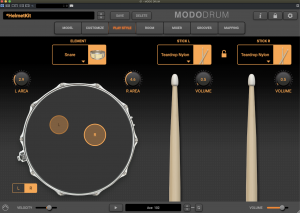
The drums themselves come through the mix with immediacy, punch, and realism. The subtle nuances that get programmed in to humanize performances pay off in spades with MODO DRUM, giving sounds that are dimensional and frankly, very difficult to distinguish from “the real thing”. Tweaking individual drums’ parameters to suit the mix was effortless – and it really felt like MODO has a strong advantage over their competition. Look at us, ma! We’re halfway across the “realism gap” already!
As any drummer will tell you, it starts with the kick and you can tell that IK chose to really focus on giving MODO DRUM not just a great palette of drums and tones – but the way they cut through even dense mixes feels like a hot knife to butter. And genres be damned, I noted the “EXTREME” kick actually worked quite well on a more AOR-rock type mix. Don’t let those goofy Guy Fieri flames on the drums fool you (and hey, IK? No self-respecting drummer outside of a Poison Cover Band Cover Band would play something that looks like that – so cut it out).
Snares were MOSTLY excellent with a few that just outclassed the rest. In particular, the piccolo could actually be given some additional shell depth and tuned down just a bit to create a “holy grail” type tone – just enough weight to thump but with enough pang to slice through. The “Reference” snare and toms also showed great versatility in tones to my ears, especially after you take the time to really dive into editing the area of the stick hits.
One particular place the shells shone brightly was with repeated tom or kick strikes, like several eighth notes in a row. You could really believe that the resonance and decay of the drum were sympathetic to the additional hits before the one before had “settled”. In other words, it sounded and behaved like an actual drum. The decays in particular really lent a profound realism. And the crossing of the gap continues until…
…the cymbals. Cymbals were more of a mixed bag with MODO. Choices are a bit more limited. The obviousness of the sampling takes a bit more work to get around. Hi-hats and rides were a sore spot – requiring more velocity editing than might be required elsewhere. And this really is the first place I listen if I’m trying to suss out if a drum performance is “real or Memorex”. Rock-type patterns where the drums tend to just lay into a clanging open pair of hi-hats could get very fake-sounding, very fast. Setting a MIDI CC to the hi-hat cymbal spacing was a big help, just putting slight variations (from say 115 to 127) helped. I could still tell… but I was operating on inside information. Would the average listener know? Probably not.
My suggestion – and one that doesn’t seem to be addressed in this release, is giving users an option of a “low CPU stress mode” for tracking – letting the people in session hear enough to keep it moving without tinkering with buffer settings or disabling tons of plug-ins. Then, come mix-down time, kick the buffer way up, flip MODO back into “cycle-munching hyper-perfect-instrument mode” and let it do its thing (then freeze or print the results). It’s the addition of those considerations that make good software great. Granted, I am not using the most powerful computer on earth, I’d say it’s right in the middle of what people are recording with these days. Would a shiny new, porked-out Bosch Toaster Mac Pro™ handle this better? Yes, of course. And if you’re the lucky owner of one – or any newer 12-core-or-higher processors, this likely won’t apply to you.
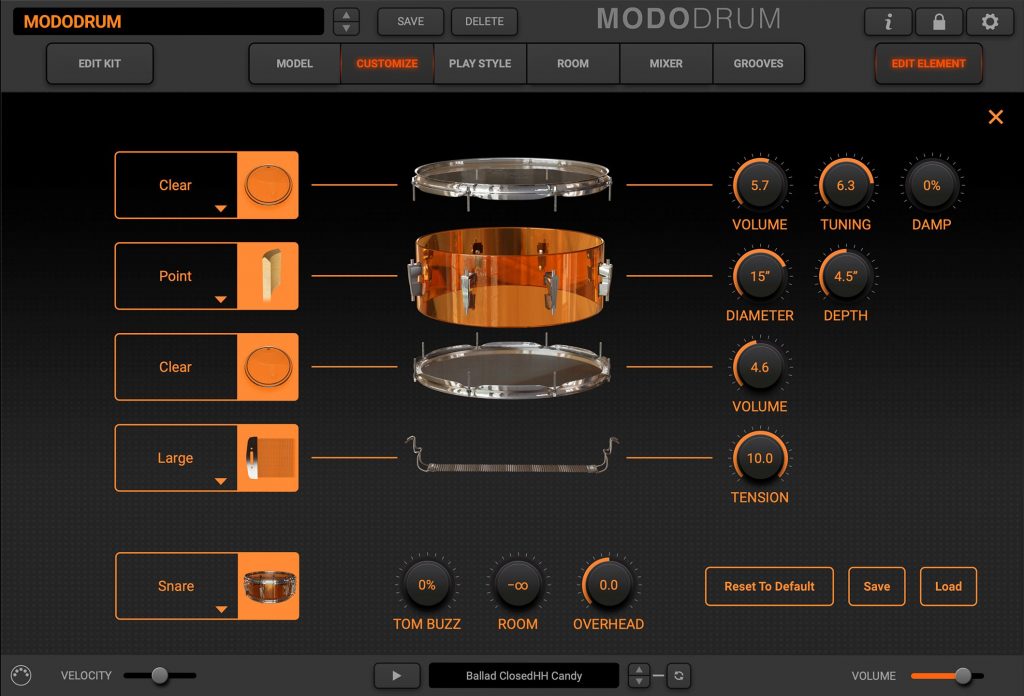
But again, it all comes down to one thing more than anything else: How does it sound? Where are we with that “realism gap”? With good performances and deft editing? I’d say you could make it almost all of the way across. Once the cymbals get the benefit of the same physical modeling detail there will simply be MODO… and then everything else. And to be sure, MODO sounds GOOD. Kicks can be chesty, breathy, pounding, scooped, round or rumbling. Snares are extremely versatile and laden with vast amounts of subtlety. Toms can be worked all the way from tonal jazzy patchwork to the #MetalAF intro to “Raining Blood”
The available cymbals are still…. let’s go with “workable” for right now. Pretty good. Not great. Still have some water to cover there. But the acoustic environments? Yes, I believe them just as much as I would any reverb preset (I’m a product of the 90’s studio scene, I don’t use a lot of it). The way the drums react with them – with kicks pushing cymbal decays out of the way with natural compression – feels tangible and dimensional.
PACKING UP YOUR KIT
Despite being a very new entry into an increasingly crowded market, let me just say this up front: MODO is impressive. Damn impressive. Using physical modeling over samples is a major leap forward in the way we recreate acoustic instruments – and the importance of this being “the new way” can NOT be understated. The computing horsepower to make this kind of thing even possible on desktop computers is only a very recent reality – but as Intel is no doubt working on their 35th generation, i17, 64-core monster, more and more project studios will have the necessary heft to run it without compromise.
To be fair, MODO DRUM is spanking new (version 1.1.1 as of press time). And as new software tends to go, subsequent revisions, point ones and so on address the real-world pain tests of their users. My criticisms are fair: Mono outputs for mono sources is a must. Individual outs for multiple drum mics? Yes. Please. And by continuing to apply their physical modeling breakthrough just as much to the cymbals as they do the shells? It’s going to make the power of this new software an absolute game-changer by v2, if not v1.3.
You’ll hear a lot of differing views on what “the best” virtual drum instrument out there is. These differing opinions are often coupled online with brash assertions about your mother and/or sexuality. But like everything else in the recording world, your ears are the ultimate judge. The deeper I wandered into its capabilities and editing features, the more I could see just how much MODO DRUM is shaping the future. Once you’ve mastered how to harness its raw power, it leaves its contemporaries in the dust.
We’ll one day look back at multi-sampled, 50GB drum libraries the same way we do using ROM samples on a Korg Triton. IK Multimedia has planted their flag with MODO Drum. It’s not quite all of the way to “perfect” as of v1.1, but they’re really, really, really close. You can either switch now or wait while a few nits are ironed out – but you will be switching. Just think of the hard drive space you’ll be freeing up.
Make no mistake – the future of virtual drum instruments is here.
For more information and to purchase visit our affiliate link HERE



